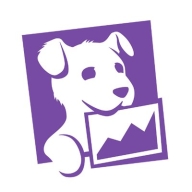

Datadog and Zscaler compete in the monitoring and security solutions category. Datadog appears to have the upper hand in features and monitoring capabilities, while Zscaler excels in security and integration.
Features: Datadog offers hosted solutions, shareable dashboards, and extensive integrations. Its tagging and visualization capabilities provide excellent support for root cause analysis. Zscaler's Zero Trust Exchange Platform includes robust security features, eliminating frequent authentication requirements, and offers seamless integration with cloud services for comprehensive data protection.
Room for Improvement: Datadog could improve its granular control over dashboards and simplify its pricing model, while also providing more application-level insights. Zscaler could enhance control over configuration settings, address network latency issues, and revise its pricing and licensing models for better value.
Ease of Deployment and Customer Service: Both Datadog and Zscaler offer flexible deployment across cloud environments. Datadog is easy to deploy but hindered by complex billing. Its customer service is responsive but has inconsistent technical support. Zscaler provides excellent support and rapid response, although some users find it less proactive in resolving complex issues.
Pricing and ROI: Datadog's pricing is seen as high and complex, sometimes resulting in unexpected costs, but its ROI is valued for saving time in bug detection. Despite its cost, users appreciate its comprehensive features. Zscaler is also costly, with flexible pricing for large environments. Its robust security value justifies the investment for companies seeking enhanced security protocols.
We don't have to purchase many components such as load balancers and proxy servers that were necessary in traditional setups.
Sometimes, support takes time since the solution has some bugs that need fixing.
In future updates, I would like to see AI features included in Datadog for monitoring AI spend and usage to make the product more versatile and appealing for the customer.
The documentation is adequate, but team members coming into a project could benefit from more guided, interactive tutorials, ideally leveraging real-world data.
There should be a clearer view of the expenses.
They might be able to identify if something is missing with Zscaler.
The setup cost for Datadog is more than $100.
Our architecture is written in several languages, and one area where Datadog particularly shines is in providing first-class support for a multitude of programming languages.
The technology itself is generally very useful.
The solution is cloud-based with the latest inspection engines, which I find to be amazing.


Datadog is a comprehensive cloud monitoring platform designed to track performance, availability, and log aggregation for cloud resources like AWS, ECS, and Kubernetes. It offers robust tools for creating dashboards, observing user behavior, alerting, telemetry, security monitoring, and synthetic testing.
Datadog supports full observability across cloud providers and environments, enabling troubleshooting, error detection, and performance analysis to maintain system reliability. It offers detailed visualization of servers, integrates seamlessly with cloud providers like AWS, and provides powerful out-of-the-box dashboards and log analytics. Despite its strengths, users often note the need for better integration with other solutions and improved application-level insights. Common challenges include a complex pricing model, setup difficulties, and navigation issues. Users frequently mention the need for clearer documentation, faster loading times, enhanced error traceability, and better log management.
What are the key features of Datadog?
What benefits and ROI should users look for in reviews?
Datadog is implemented across different industries, from tech companies monitoring cloud applications to finance sectors ensuring transactional systems' performance. E-commerce platforms use Datadog to track and visualize user behavior and system health, while healthcare organizations utilize it for maintaining secure, compliant environments. Every implementation assists teams in customizing monitoring solutions specific to their industry's requirements.
Zscaler Zero Trust Exchange Platform acts as a VPN alternative for secure remote access, cloud protection, and zero-trust strategies. It enables secure data transmission, supports remote work, and enhances compliance through a cloud-based architecture, offering improved performance and simplified management.
Designed for organizations seeking secure application access and robust data protection, Zscaler Zero Trust Exchange Platform delivers a comprehensive solution through seamless VPN connectivity, data loss prevention, and SSL inspection. Its cloud integration ensures scalability and reliability, while its interface provides intuitive management. Companies benefit from automatic secure access, minimizing constant authentication needs, and safeguarding sensitive data. The platform allows easy deployment and integration with diverse identity providers, granting granular control for access and application segmentation. Despite powerful capabilities, enhancements are needed in speed, bandwidth, and legacy support, with users noting interface and configuration challenges.
What are the key features of Zscaler Zero Trust Exchange Platform?In specific industries, Zscaler Zero Trust Exchange has been implemented to enhance security protocols in fields like finance and healthcare. By prioritizing data protection and compliance, it assists companies in safely managing sensitive information and meeting regulatory requirements. Organizations leverage its features to ensure secure operations across remote and cloud environments, adapting to industry-specific needs with customizable access and security controls.
We monitor all Cloud Security Posture Management (CSPM) reviews to prevent fraudulent reviews and keep review quality high. We do not post reviews by company employees or direct competitors. We validate each review for authenticity via cross-reference with LinkedIn, and personal follow-up with the reviewer when necessary.